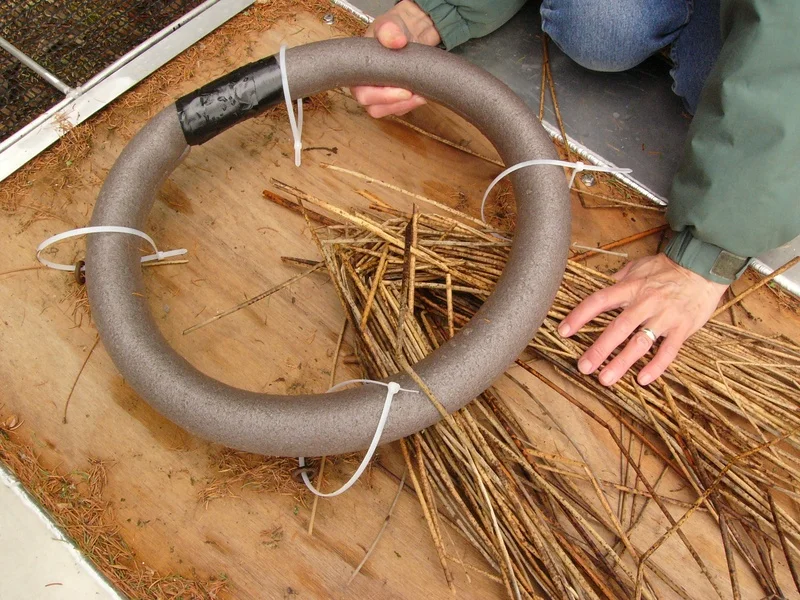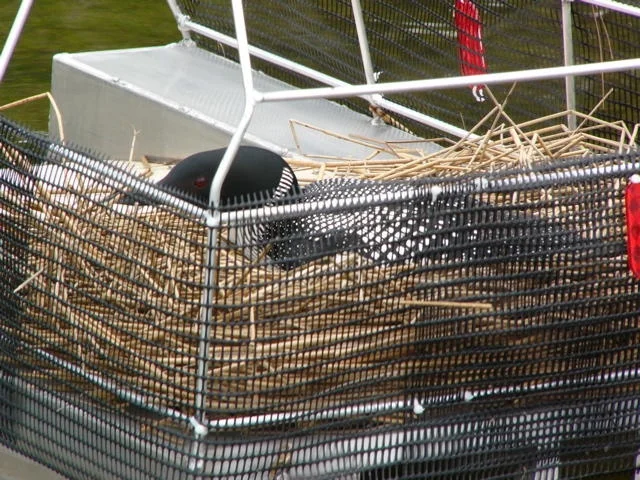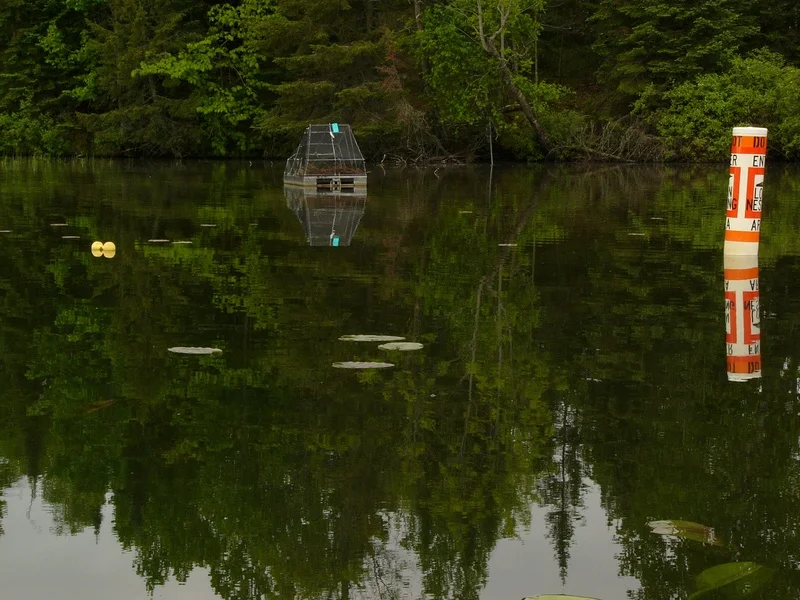Loon Platform Assembly
Access Ramp & Material
The access ramp is contained within the raft to make the raft compact for easy handling. Some loon families have used the rafts for three weeks after hatching. Loons usually do not return to natural shoreline nests after the chicks have hatch because of potential predation, as well as the difficulty for chicks to climb back on a shore nest.
Platform and Ramp Material
3/8" marine plywood is preferred for the platform and ramp; however, if it is unavailable exterior plywood can be substituted. Green treated plywood can be toxic. The plywood is fastened to the raft frame with stainless steel 1/4"-20 x 1" hex head cap screws with washers and nylon locknuts.
Texturing the ramp plywood will help the chicks return to the nest and warm up. The ramp can be textured with coarse abrasives or by shallow parallel saw (kerf) cuts about 1" apart.
In an experiment to give the rafts a more "natural" appearance, several raft ramps have been covered with bulrushes. See photos No. 24 & No. 25. At this time, there is no evidence of success.
Nest Ring
The function of the nest ring is twofold; first the ring prevents the eggs from rolling off the raft, and second, the ring keeps the natural vegetation from blowing off the platform. The nesting ring is made up of a 4 ft. length of garden hose, inside foam pipe insulation (1" I.D. x 1 3/4" O.D.). The interior diameter of the nest ring is 12" to 13" (McIntyre, p. 24). The hose ends are joined with a 5/8" wood dowel about 2" long forced into the hose ends.
Small screws can be used to fasten the hose to the dowel if the joint is too loose. The foam pipe insulation joint is covered with duct tape.
Attaching Nest Ring
The nest ring is placed on top of the natural vegetation and secured with 18” plastic cable ties (-41 degrees grade) through four eye screws in the plywood platform. Lesser grade cable ties will break in freezing temperatures. We use 6", 12", and 18" length cable ties to attach the nesting ring and canopy screen.
Place the nesting ring deep inside the raft.
Experiment
In an experiment to give the rafts a more "natural" appearance, several raft ramps have been covered with bulrushes. See photos
At this time, there is no evidence of success
Canopy
Loons prefer to enter and exit the nest undetected, (McIntyre, Nests, p. 20-28). The raft canopy provides a screen to reduce detection and to give a sense of security. Too many human intruders can be detrimental as the incubating loon is turned into a "flusher" loon, which may abandon the nest.
The shape of the canopy is high in the bow and lower in the stern (ramp end).
Thirty inches of space above the nest area is provided for loon copulation (McIntyre Plate No. 1). The low canopy at the stern reduces possible detection by shore predators while giving the loon good visibility, and aids the loon in slipping off the raft undetected. At this time there has been no predation on the Big Mantrap Lake rafts.
Canopy Frame and Screen
The exposed rods of the canopy frame provide protection from large aerial predators.
The plastic screen is a partial barrier when viewing the raft from a distance, while providing 360 degree visibility for the loon sitting close to the screen.
In addition the screen is a windbreak, partial shade for the dark colored incubating loon, and possibly a solar reservoir to keep the eggs warm when the loon briefly leaves the nest. The Big Mantrap Lake Association purchases the screen in large rolls and will sell screen to other lake associations. The screen is attached to the canopy frame with plastic cable ties.
Loons encountering a nesting raft with a fully enclosed plastic canopy screen may consider the raft to be a trap and thus avoid the raft. To condition loons to the plastic canopy covering, the screen is added in two phases. The first year screen is 10"-12" high on three sides of the canopy base. This is sufficient for the loon to remain undetected in their head down hangover posture. Loons returning to nest in the following year have readily accepted a completely covered canopy.
Loon Raft Location
Loons prefer to nest on islands or areas out of the wind (McIntyre, pp 20-28).
Emergent vegetation is desirable for the chick nursery. Deep water nearby can help loons escape predators, as well as providing a margin of safety against fluctuating water levels. The bow or closed end of the raft is anchored facing open water, onshore waves and curious boaters. The stern or ramp end of the raft is anchored facing shore. The raft distance from shore varies with the site, but far enough away from shore to avoid discovery by shoreline predators.
On large bulrush beds the raft can be located inside the outer edge of the bed.
Anchors
Large (200 oz., 1 1/2 gal.) detergent bottles filled with concrete serve as anchors for the nest sites out of wind. Before the concrete sets up a length of large chain is suspended in the concrete with one end exposed to attach the rope snaps. These anchors are compact, have a smooth exterior, and a handle. The wind prone nest sites on Big Mantrap Lake require heavy naval type anchors with hinged flukes. Generally 28 lb. anchors are used on the bow toward open water and 20 lb. anchors on the stern toward shore.
Anchor Lines
Anchor lines are 3/8" nylon rope with the largest size brass rope snaps (251B-3) tied to each end. Rope snaps are quite adequate for general use.
For rough water sites a quick link or carabiner (3/8”), used in sports requiring rope work can be used. Anchor lines are 15-20 ft. long.
Buoys and Territory Markers
Curious human intruders and occasional insensitive fishermen are potential problems for nesting loons. One LOON NESTING regulatory buoy in combination with yellow fishing markers is used to define the loon's nesting territory. This system has been mostly successful in alerting potential intruders and giving the loons a secure space. Rolyan Buoys, Inc. makes an excellent regulatory buoy, with a silhouette of a loon, and the words CAUTION, LOON NESTING AREA.
Yellow Lindy-Little Joe fishing markers are used to form an arc to define the perimeter of the nest territory. The regulatory buoy is placed in the center apex of the arc about 30 ft. from the nest. The fishing markers are restrung with 1/8" nylon rope, because the line issued with the marker is not durable. The length of the nylon ropes must be sufficient to accommodate the water depth as well as potential wave height. See the DNR MINNESOTA BOATING GUIDE for Water Marker information.
Register Rafts with the County Sheriff’s Office
Notify the Sheriff Department of intent to place rafts on your lake. Register rafts with the County Sheriff’s Office and attach registration numbers to the rafts. The nesting rafts will require reflectors.
Fasteners
Bolts (cap screws), nuts, and washers should be stainless steel as other metals in contact with aluminum will degrade through corrosion. Lock nuts with nylon inserts work best with cap screws.
Loon Watcher Program
Record your loon observations with the Minnesota Loon Watcher Program.
For information contact: Pam Perry, Minnesota Department of Natural
Resources, Regional Supervisor, Ecological and Water Resources, Nongame
Wildlife Specialist and Minnesota Loon Watcher coordinator. Phone: 218. 833.8728
E-mail: pam.perry@dnr.state.mn.us
Common Loon Research
THE COMMON LOON: SPIRIT OF THE NORTH, by Judith W. McIntyre, University of Minnesota Press, 1988, ISBN0-8166-1651-5 with its reference data has been an essential guide during development of our nesting raft.
The May/June 2011, American Scientist article, "Marking Loons, Making Progress" by Walter Piper, Jay Mager and Charles Walcot contains 18 years of shared common loon research. Their research pioneers significant new insights into loon behavior. These loon references will be of major importance in explaining loon behavior witnessed on your lake.
Woodworking for Wildlife
WOODWORKING FOR WILDLIFE, by Carrol Henderson, published in 2009, by the Minnesota Department of Natural Resources notes the Big Mantrap Lake Association loon nesting raft.
DNR Nongame Tax Check Off
Please remember the DNR Nongame Tax Check Off when you are filing your Minnesota tax form. When renewing your vehicle license plates, a Critical Habitat donation will provide you with a special loon or other species plate. If you reside in a state other than Minnesota, perhaps your state has opportunities similar to those listed above.

Access Ramp & Material

Photo No. 7, Cutting bulrushes w/snow shovel

Bulrush Storage

Brush Storage w/tarp

Nest Ring

Nest ring, hose exposed

Arlis McGinnis w/Canopy Open

Nest Circle, 16 1/2" dia. w/eye screws

18" Cable ties through eye scres

Cable ties secured only at ends

Nest ring elevated for bulrush insertion

Bulrushes under nest ring (1)

Bulrushes under nest ring (2)

Bulrushes under nest ring (3)

Sedge grass under nest ring

Sedge grass completed

Drawing down nest ring

Excess trimmed, sharp ends rotated below bulrushes

Raft ramp, ties and stick (experimental)

Secured bulrushes (experimental)

Raft completed

First year screen phase

Raft w/full screen cover w/reflectors

Cast anchor, 25 lb

Anchor w/hinged flukes

Rope Snap

Roylan Buoy

Lindy, territory marker

Buoy with territory markers

Buoy, with territory markers
